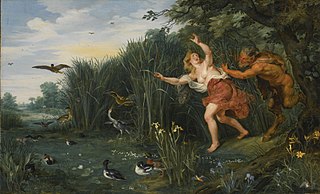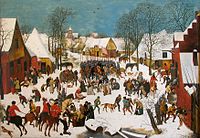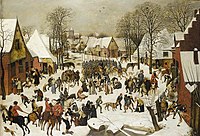
Pieter Brueghelthe Younger was a Flemish painter known for numerous copies after his father Pieter Bruegel the Elder's work, as well as his original compositions. The large output of his studio, which produced for the local and export market, contributed to the international spread of his father's imagery.

Pieter Bruegelthe Elder was the most significant artist of Dutch and Flemish Renaissance painting, a painter and printmaker, known for his landscapes and peasant scenes ; he was a pioneer in making both types of subject the focus in large paintings.

Jan Brueghelthe Elder was a Flemish painter and draughtsman. He was the son of the eminent Flemish Renaissance painter Pieter Bruegel the Elder. A close friend and frequent collaborator with Peter Paul Rubens, the two artists were the leading Flemish painters in the first three decades of the 17th century.

Jan Brueghelthe Younger was a Flemish Baroque painter. He was the son of Jan Brueghel the Elder, and grandson of Pieter Bruegel the Elder, both prominent painters who contributed respectively to the development of Renaissance and Baroque painting in the Habsburg Netherlands. Taking over his father's workshop at an early age, he largely painted the same subjects as his father in a style which was similar to that of his father. He gradually was able to break away from his father's style by developing a broader, more painterly, and less structured manner of painting. He regularly collaborated with leading Flemish painters of his time.

"Musée des Beaux Arts" is a poem written by W. H. Auden in December 1938 while he was staying in Brussels, Belgium, with Christopher Isherwood. It was first published under the title "Palais des beaux arts" in the Spring 1939 issue of New Writing, a modernist magazine edited by John Lehmann. It next appeared in the collected volume of verse Another Time, which was followed four months later by the English edition. The poem's title derives from the Musées Royaux des Beaux-Arts de Belgique, the French-language name for the Royal Museums of Fine Arts of Belgium located in Brussels. The museum is famous for its collection of Early Netherlandish painting. When Auden visited the museum he would have seen a number of the paintings of the "Old Masters" referred to in the second line of the poem, including the Fall of Icarus which at the time was still regarded as an original by Pieter Bruegel the Elder.

Landscape with the Fall of Icarus is a painting in oil on canvas measuring 73.5 by 112 centimetres now in the Royal Museums of Fine Arts of Belgium in Brussels. It was long thought to be by the leading painter of Dutch and Flemish Renaissance painting, Pieter Bruegel the Elder. However, following technical examinations in 1996 of the painting hanging in the Brussels museum, that attribution is regarded as very doubtful, and the painting, perhaps painted in the 1560s, is now usually seen as a good early copy by an unknown artist of Bruegel's lost original, perhaps from about 1558. According to the museum: "It is doubtful the execution is by Bruegel the Elder, but the composition can be said with certainty to be his", although recent technical research has re-opened the question.

Abraham Brueghel was a Flemish painter from the famous Brueghel family of artists. He emigrated at a young age to Italy where he played an important role in the development of the style of decorative Baroque still lifes.

Joos de Momper the Younger or Joost de Momper the Younger was a Flemish landscape painter active in Antwerp between the late 16th century and the early 17th century. Brueghel's influence is clearly evident in many of de Momper's paintings. His work is situated at the transition from late 16th-century Mannerism to the greater realism in landscape painting that developed in the early 17th century. He achieved considerable success during his lifetime.

Netherlandish Proverbs is a 1559 oil-on-oak-panel painting by Pieter Bruegel the Elder that depicts a scene in which humans and, to a lesser extent, animals and objects, offer literal illustrations of Dutch-language proverbs and idioms.

The Gloomy Day is an oil on wood painting by Pieter Bruegel the Elder in 1565. The painting is one in a series of six works, five of which are still extant, that depict different times of the year. The painting is currently in the collection of the Kunsthistorisches Museum, located in Vienna, Austria.

Marten van Cleve the Elder was a Flemish painter and draftsman active in Antwerp between 1551 and 1581. Van Cleve is mainly known for his genre scenes with peasants and landscapes, which show a certain resemblance with the work of Pieter Bruegel the Elder. Marten van Cleve was one of the leading Flemish artists of his generation. His subjects and compositions were an important influence on the work of Pieter Brueghel the Younger and other genre painters of his generation.

Christ and the Woman Taken in Adultery is a small panel painting in grisaille by the Netherlandish Renaissance printmaker and painter Pieter Bruegel the Elder. It is signed and dated 1565.

The Adoration of the Kings is an oil-on-panel painting of the Adoration of the Magi by the Netherlandish Renaissance artist Pieter Bruegel the Elder, painted in 1564, and now in the National Gallery, London.

Conversion of Paul is an oil-on-panel by the Netherlandish Renaissance artist Pieter Bruegel the Elder, painted in 1567. It is currently held and exhibited at the Kunsthistorisches Museum in Vienna.

The Procession to Calvary is an oil-on-panel by the Netherlandish Renaissance artist Pieter Bruegel the Elder of Christ carrying the Cross set in a large landscape, painted in 1564. It is in the Kunsthistorisches Museum in Vienna.

The Census at Bethlehem is an oil-on-panel by the Flemish Renaissance artist Pieter Bruegel the Elder, painted in 1566. It is signed and measures about 1155 × 1645 mm. It is currently held and exhibited at the Royal Museums of Fine Arts of Belgium in Brussels, which acquired it in 1902. It is one of the first paintings in Western art to feature a significant snow landscape and was painted in the aftermath of the winter of 1565, which was one of the harshest winters on record.

The Suicide of Saul is an oil-on-panel by the Netherlandish Renaissance artist Pieter Bruegel the Elder, painted in 1562. It is in the collection of the Kunsthistorisches Museum in Vienna.

Winter Landscape with Ice-skaters and Bird-trap is a 1565 painting attributed to the Flemish painter Pieter Bruegel the Elder, located in the Royal Museums of Fine Arts of Belgium in Brussels. It shows a village scene where people skate on a frozen river, while on the right among trees and bushes, birds gather around a bird trap. It has become known as the original or oldest exemplar of the most successful painting of the Brueghel family dynasty, since the art historian Klaus Ertz documented 127 copies in his comprehensive monograph on the artist's son in 2000.

The Brueghel family, also spelled Bruegel or Breughel, is an extended family of Dutch and Flemish painters which played a major role in the development of the art in Brabant and Flanders throughout the 16th and 17th centuries. Due to the organisation in guilds and training being done with established painters and not in schools or academies, painters often passed on the knowledge from father to son, and there are many examples of Flemish painting families spanning two or more generations, e.g. the Francken family, which had at least ten painters spanning four generations. The Brueghel family produced the largest number of major painters of all Flemish families.

Grotto Landscape with a Hermitage, also called The Reading Hermit, is an oil on canvas painting by Flemish painters Jan Brueghel the Younger and Joos de Momper. It was painted around 1625, and is currently in private collection. It depicts a reading hermit in a monumental grotto, several pilgrims and various animals. It was painted in Antwerp.

























